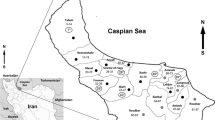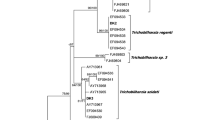Abstract
In Europe, despite of intensive work on avian schistosomes in the past, only one representative of nasal schistosomes has been detected so far, Trichobilharzia regenti, a species that remained undescribed to the scientific community until 1998. Since then, however, T. regenti has gained a considerable attention, not only due to the induction of serious lesions concomitant with the migration of the schistosomulae through the central nervous system of their natural hosts (birds) but also due to their implication in cercarial dermatitis and their neurotrophic behaviour in mammals (mice, experimental) where the parasite migrate to the CNS. From 2001 to 2010, by a parasitic control of various potential final hosts (aquatic birds) living in natural condition in France and in Iceland, we detected T. regenti in six species: Anas platyrhynchos, Cygnus olor, Aythya fuligula, Aythya ferina, Mergus merganser and Anser anser. Although morphological features, mainly of eggs, showed some variations with the original description of the parasite, molecular analysis confirmed their membership to the T. regenti species. Nevertheless, specific molecular and morphological variations were especially observed for nasal parasite isolated from Anas clypeata. For this species, we discuss the possibility for this nasal schistosome to belong to a nasal Trichobilharzia species already described in Africa or even an undescribed nasal species.


Similar content being viewed by others
References
Aldhoun JA, Kolárová L, Horák P, Skírnisson K (2009) Bird schistosome diversity in Iceland: molecular evidence. J Helminthol 83(2):173–180
Bargues MD, Horák P, Patzner RA, Pointier JP, Jackiewicz M, Meier-Brook C, Mas-Coma S (2003) Insights into the relationships of Palaearctic and Nearctic Lymnaeids (Mollusca: Gastropoda) by rDNA its-2 sequencing and phylogeny of stagnicoline intermediate host species of Fasciola hepatica. Parasite 10(3):244–255
Bayssade-Dufour C, Jouet D, Rudolfová J, Horák P, Ferté H (2006) Seasonal morphological variations in bird schistosomes. Parasite 13(3):205–214
Bearup AJ (1957) Schistosomes in the nasal passages of aquatic birds. Aust J Sci 19:163
Blair D, Islam KS (1983) The life-cycle and morphology of Trichobilharzia australis n.sp. (Digenea: Schistosomatidae) from the nasal blood vessels of the black duck (Anas superciliosa) in Australia, with a review of the genus Trichobilharzia. Syst Parasitol 5:89–117
Blair D, Ottesen P (1979) Nasal schistosomiasis in Australian anatids. J Parasitol 65(6):982–984
Blazová K, Horák P (2005) Trichobilharzia regenti: the developmental differences in natural and abnormal hosts. Parasitol Int 54(3):167–172
Chanová M, Horák P (2007) Terminal phase of bird schistosomiasis caused by Trichobilharzia regenti (Schistosomatidae) in ducks (Anas platyrhynchos f. domestica). Folia Parasitol (Praha) 54(2):105–107
Dvořák J, Vancova S, Hampl V, Flegr J, Horák P (2002) Comparison of European Trichobilharzia species based on ITS1 and ITS2 sequences. Parasitology 124(3):307–313
Fain A (1955a) Une nouvelle bilharziose des oiseaux: la trichobilharziose nasale. Remarque sur l’importance des schistosomes d’oiseaux en pathologie humaine. Note préliminaire. Ann Soc Belge Med Trop (1920) 35(3):323–327
Fain A (1955b) Recherche sur les schistosomes d'oiseaux au Ruanda-Urundi (Congo belge). Découverte d'une nouvelle bilharzie aviaire: la Trichobilharzie nasale, et description de schistosomes nouveaux. Note préliminaire. Rev Zool Bot Afr 51:373–387
Fain A (1956a) Les schistosomes d'oiseaux du genre Trichobilharzia Skrjabin et Zakharow, 1920 au Ruanda-Urundi. Rev Zool Bot Afr 54:147–178
Fain A (1956b) Nasal trichobilharziasis: a new avian schistosomiasis. Nature 177(4504):389
Fain A (1959) Un nouveau schistosome du genre Trichobilharzia dans les fosses nasales du Canard nain. Rev Zool Bot Afr 60:227–232
Horák P, Kolárová L (2005) Molluscan and vertebrate immune responses to bird schistosomes. Parasite Immunol 27(7–8):247–255
Horák P, Kolářová L, Dvořák J (1998) Trichobilharzia regenti n. sp. (Schistosomatidae, Bilharziellinae), a new nasal schistosome from Europe. Parasite 5(4):349–357
Horák P, Kolářová L, Adema CM (2002) Biology of the schistosome genus Trichobilharzia. Adv Parasitol 52:155–233
Hrádková K, Horák P (2002) Neurotropic behaviour of Trichobilharzia regenti in ducks and mice. J Helminthol 76(2):137–141
Islam KS (1986) The morphology and life-cycle of Trichobilharzia arcuata n. sp. (Schistosomatidae: Bilharziellinae) a nasal schistosome of water whistle ducks (Dendrocygna arcuata) in Australia. Syst Parasitol 8:117–128
Jouet D, Ferté H, Hologne C, Kaltenbach ML, Depaquit J (2009) Avian schistosomes in French aquatic birds: a molecular approach. J Helminthol 83(2):181–189
Kourilová P, Syrucek M, Kolářová L (2004) The severity of mouse pathologies caused by the bird schistosome Trichobilharzia regenti in relation to host immune status. Parasitol Res 93(1):8–16
Kumar S, Tamura K, Neï M (2004) MEGA3: integrated software for molecular evolutionary genetics analysis and sequence alignment. Brief Bioinform 5(2):150–163
Mollaret I, Jamieson BG, Adlard RD, Hugall A, Lecointre G, Chombard C, Justine JL (1997) Phylogenetic analysis of the Monogenea and their relationships with Digenea and Eucestoda inferred from 28 S rDNA sequences. Mol Biochem Parasitol 90(2):433–438
Palmer D, Ossent P (1984) Nasal schistosomiasis in Mute Swans in Switzerland. Rev Suisse Zool 91:709–715
Picard D, Jousson O (2001) Genetic variability among cercariae of the Schistosomatidae (Trematoda: Digenea) causing swimmer's itch in Europe. Parasite 8:237–242
Rudolfová J, Sitko J, Horák P (2002) Nasal schistosomes of wildfowl in the Czech Republic. Parasitol Res 88(12):1093–1095
Rudolfová J, Littlewood DT, Sitko J, Horák P (2007) Bird schistosomes of wildfowl in the Czech Republic and Poland. Folia Parasitol (Praha) 54(2):88–93
Skírnisson K, Kolářová L (2008) Diversity of bird schistosomes in anseriform birds in Iceland based on egg measurements and egg morphology. Parasitol Res 103(1):43–50
Skírnisson K, Aldhoun JA, Kolárová L (2009) A review on swimmer's itch and the occurrence of bird schistosomes in Iceland. J Helminthol 83(2):165–171
van Bolhuis GH, Rijks JM, Dorrestein GM, Rudolfová J, van Dijk M, Kuiken T (2004) Obliterative endophlebitis in Mute Swans (Cygnus olor) caused by Trichobilharzia sp. (Digenea: Schistosomatidae) infection. Vet Pathol 41(6):658–665
Webster BL, Rudolfová J, Horák P, Littlewood DT (2007) The complete mitochondrial genome of the bird schistosome Trichobilharzia regenti (Platyhelminthes: Digenea), causative agent of cercarial dermatitis. J Parasitol 93(3):553–561
Wilson RB, New JC, Scholtens RG (1982) Granulomatous encephalitis caused by schistosomiasis in swans. J Am Vet Med Assoc 181:1386–1387
Wojcinski ZW, Barker IK, Hunter DB, Lumsden H (1987) An outbreak of schistosomiasis in Atlantic brant geese, Branta bernicola hrota. J Wildl Dis 23:248–255
Acknowledgments
In France, the authors would like to thank Yves Maupoix and the ONCFS technical staff (Office National de la Chasse et de la Faune Sauvage) of Der-Chantecoq Lake, staff of Departmental Veterinarian Laboratories (Aube, Haute-Savoie) and SAGIR networks for their help in providing samples. In Iceland, Arni Einarsson, Broddi Hilmarsson, Gudmundur Björnsson, Gudmundur Tryggvi Olafsson, Thorkell L. Thorarinsson and Thorvaldur Björnsson are thanked for help with bird sampling. The authors would also like to thank Jitka A. Aldhoun and Libor Mikes for their valuable help by autopsying some of the birds in Iceland in August 2003. Financial support for this study was provided by ONCFS, SILA, the Town Council of Beauvais, and the Research Fund of the University of Iceland.
Author information
Authors and Affiliations
Corresponding author
Rights and permissions
About this article
Cite this article
Jouet, D., Skírnisson, K., Kolářová, L. et al. Final hosts and variability of Trichobilharzia regenti under natural conditions. Parasitol Res 107, 923–930 (2010). https://doi.org/10.1007/s00436-010-1953-4
Received:
Accepted:
Published:
Issue Date:
DOI: https://doi.org/10.1007/s00436-010-1953-4




